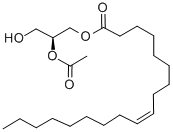

IdentificationPhysical DataSpectraRoute of Synthesis (ROS)Safety and HazardsOther Data
Identification
Product Name1-OLEOYL-2-ACETYL-SN-GLYCEROL IUPAC Name (Z)-octadec-9-enoateMolecular StructureCAS Registry Number 86390-77-4MDL NumberMFCD00166985Synonyms3-Pyridinamin;3-Pyridinamine;3-Pyridinamine;pyridin-3-amine;T6NJ CZ;3- Aminopyridine;3-Amino-pyridine;3-pyridylamine;Amino-3 pyridine;m-1-Oleoyl-2-acetyl-sn-glycerol86390-77-4Oleoylacetylglycerol1-Oleyl-2-acetylglycerol1-oleoyl-2-acetyl-glycerololeyl acetyl glycerol1-O-Octadecenoyl-2-O-acetylglycerol2-Acetyl-1-oleoyl-sn-glycerolsn-1-Oleoyl-2-acetylglycerol(2S)-2-acetyloxy-3-hydroxypropyl-octadec-9-enoate1-oleoyl-2-acetylglycerol1-O-9Z-Octadecenoyl-2-O-acetyl-sn-glycerol9-Octadecenoic acid (Z)-, 2-(acetyloxy)-3-hydroxypropyl ester, (S)-9-Octadecenoic acid (9Z)-, (2S)-2-(acetyloxy)-3-hydroxypropyl ester1-Oleoyl-2-acetyl-sn-glycerol (OAG)OAG1-Oleoyl-2-acetyl-rac-glycerolBSPBio_0014031-Olein-2-acetyl-sn-glycerolBML2-F08Molecular FormulaC23H42O5 Molecular Weight398.6InChIInChI=1S/C23H42O5/c1-3-4-5-6-7-8-9-10-11-12-13-14-15-16-17-18-23(26)27-20-22(19-24)28-21(2)25/h10-11,22,24H,3-9,12-20H2,1-2H3/b11-10-/t22-/m0/s1InChI KeyPWTCCMJTPHCGMS-YRBAHSOBSA-NCanonical SMILESCCCCCCCC/C=CCCCCCCCC(=O)OC(CO)OC(=O)C
Patent InformationPatent IDTitlePublication DateEP334586Carbohydrate lactam derivatives and their use in cosmetic compositions1989
Physical Data
AppearanceColorless to slightly yellow oily liquid
Spectra
Description (NMR Spectroscopy)Nucleus (NMR Spectroscopy)Solvents (NMR Spectroscopy)Frequency (NMR Spectroscopy), MHzChemical shifts, Spectrum1HChemical shifts1Hchloroform-d1400Chemical shifts13Cchloroform-d1100Chemical shifts13CCDCl3100Chemical shifts1HCDCl3400
Route of Synthesis (ROS)
Route of Synthesis (ROS) of 1-OLEOYL-2-ACETYL-SN-GLYCEROL CAS 86390-77-4
ConditionsYieldWith pyridine; methanol In tetrahydrofuran at 20℃; for 3h;100%With pyridine In tetrahydrofuran; methanol at 20℃; for 3h;100%With pyridine; methanol In tetrahydrofuran at 20℃; for 2h;100%
Safety and Hazards
GHS Hazard StatementsNot Classified
Source: European Chemicals Agency (ECHA)License Note: Use of the information, documents and data from the ECHA website is subject to the terms and conditions of this Legal Notice, and subject to other binding limitations provided for under applicable law, the information, documents and data made available on the ECHA website may be reproduced, distributed and/or used, totally or in part, for non-commercial purposes provided that ECHA is acknowledged as the source: “Source: European Chemicals Agency, http://echa.europa.eu/”. Such acknowledgement must be included in each copy of the material. ECHA permits and encourages organisations and individuals to create links to the ECHA website under the following cumulative conditions: Links can only be made to webpages that provide a link to the Legal Notice page.License URL: https://echa.europa.eu/web/guest/legal-noticeRecord Name: (1-Cyano-2-ethoxy-2-oxoethylidenaminooxy)dimethylamino-morpholino-carbenium hexafluorophosphateURL: https://echa.europa.eu/information-on-chemicals/cl-inventory-database/-/discli/details/213446Description: The information provided here is aggregated from the “Notified classification and labelling” from ECHA’s C&L Inventory. Read more: https://echa.europa.eu/information-on-chemicals/cl-inventory-database
Other Data
TransportationStore at -20℃ and away from light.HS CodeStorageStore at -20℃ and away from light.Shelf Life1 yearMarket Price
DruglikenessLipinski rules componentMolecular Weight398.583logP7.872HBA5HBD1Matching Lipinski Rules3Veber rules componentPolar Surface Area (PSA)72.83Rotatable Bond (RotB)21Matching Veber Rules1
Quantitative Results1 of 47Comment (Pharmacological Data)Bioactivities presentReferenceCarbohydrate lactam derivatives and their use in cosmetic compositions2 of 47Comment (Pharmacological Data)Bioactivities presentReferenceDesign, synthesis, and structure-activity relationship of new isobenzofuranone ligands of protein kinase C3 of 47Comment (Pharmacological Data)Bioactivities presentReferenceA role for protein kinase C in the regulation of membrane fluidity and Ca2+ flux at the endoplasmic reticulum and plasma membranes of HEK293 and Jurkat cells4 of 47Comment (Pharmacological Data)Bioactivities presentReferenceEstablishment of a binding assay for protein kinase C isozymes using synthetic C1 peptides and development of new medicinal leads with protein kinase C isozyme and C1 domain selectivity5 of 47Comment (Pharmacological Data)Bioactivities presentReferenceInhibition by gangliosides GM3, GD3 and GT1b of substrate phosphorylation by protein kinase C in bovine mammary gland and its reversal by phosphatidylserine6 of 47Comment (Pharmacological Data)Bioactivities presentReferenceNK cells respond to haptens by the activation of calcium permeable plasma membrane channels7 of 47Comment (Pharmacological Data)Bioactivities presentReferenceCoupling between the TRPC3 ion channel and the NCX1 transporter contributed to VEGF-induced ERK1/2 activation and angiogenesis in human primary endothelial cells8 of 47Comment (Pharmacological Data)Bioactivities presentReferenceReduced membrane cholesterol after chronic hypoxia limits Orai1-mediated pulmonary endothelial Ca2+ entry9 of 47Comment (Pharmacological Data)Bioactivities presentReferenceTransient receptor potential channels in cardiac health and disease10 of 47Comment (Pharmacological Data)Bioactivities presentReferenceBeyond the CRAC: Diversification of ion signaling in B cells
Use Pattern1-Oleoyl-2-acetyl-sn-glycerol is used in detection, identification and characterization of interactions between ligands and their corresponding glycoprotein target receptors on living cells and in biological fluids. https://www.chemwhat.com/1-oleoyl-2-acetyl-sn-glycerol-cas-86390-77-4/
Comments
Post a Comment